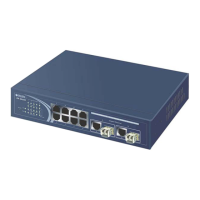vii
Caution
Circuit devices are sensitive to static electricity, which can damage their delicate
electronics. Dry weather conditions or walking across a carpeted floor may cause you to
acquire a static electrical charge.
To protect your device, always:
• Touch the metal chassis of your computer to ground the static electrical charge before
you pick up the circuit device.
• Pick up the device by holding it on the left and right edges only.
• If you need using outdoor device connect to this device with cable then you need to
addition an arrester on the cable between outdoor device and this device.
Fig. Addition an arrester between outdoor device and this switch
• The switch supports the SFP Vendor includes: Rubytech, Agilent, Avago and Finisa
Note:
The switch was for using indoor purpose, if it was used in outdoor environment or connect with cable
to outdoor then it must to use a lightning arrester to protect the switch
Electronic Emission Notices
Federal Communications Commission (FCC) Statement
This equipment has been tested and found to comply with the limits for a class A
computing device pursuant to Subpart J of part 15 of FCC Rules, which are designed to
provide reasonable protection against such interference when operated in a commercial
environment.
European Community (CE) Electromagnetic Compatibility Directive
This equipment has been tested and found to comply with the protection requirements
of European Emission Standard EN55022/EN61000-3 and the Generic European Immunity
Standard EN55024.
EMC:
EN55022(2003)/CISPR-2( 2002) class A
IEC61000-4-2 (2001) 4K V CD, 8KV, AD
IEC61000-4-3( 2002) 3V/m
IEC61000-4-4(2001) 1KV – (power line), 0.5KV – (signal line)

